Inhalt
![]()
Vorwort
Hemer
STALAGs
STALAG
VI a
Beschreibung
Westgef.&
Polen
Sowjets
Statistik
Berichte
Personal
Arbeitseinsatz
Übergabe
Befreiung
Friedhöfe
Kaserne
Mahnmal
Entschädigung
Lagerplan
Literatur
Impressum
e-mail
9.July
2002
Screen
design:
Dr.H. Fritsch
Burial places of STALAG VI A
The prisoners of war who died in the Stalag VIA were buried in special burial places or in a seperate part of the communal cemetary. Directly after the war there had been five such burial places from STALAG VI A of which three have been dissolved before the end of the fifties. Today there are two cemetaries left, Duloh and Höcklingser Weg.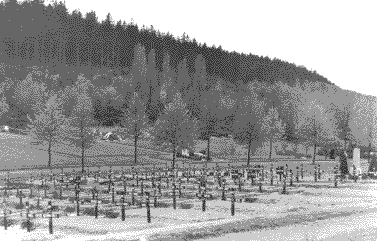 |
communal cemetary, part for Western and Polish prisoners of war, undated (1943) (Bundesarchiv - Militärarchiv Potsdam)
Graves of prisoners of war in the communal cemetary (Waldfriedhof)
South of the town center, between Sundwig and Westig the communal cemetary had been the first burial place also for prisoners of war. The town of Hemer offered this possibility to the military authorities as early as October 1939. Here prisoners from Western, Southern and Southeastern Europe and Poland had been buried.Until the end of 1939 10 Polish prisoners had deceased, until the end of 1940 from different nations 44 more died from tuberculosis, diphteria, diarrhoe, heart and circular diseases and pneumonia but also from their injuries they had suffered from action.
In the cemetary Waldfriedhof from 1939 until 1945 all in all only 332 prisoners of war had been buried: 166 French, 12 Belgian, 75 Italians, 1 Canadian, 4 British, 42 Polish, 17 Yugoslaw and 15 more of unknown nationality. These dead had been buried in simple wooden coffins. Burials there had a solemn ceremony, the coffin being accompanied by a French or a Polish priest. In some cases a honor delegation of the German Wehrmacht accompanied the funeral procession.
In 1941 one of the French Prisoners of War had been allowed to carve a tombstone in remembrance of his comrades by the commander of the camp. The tombstone has a height of about 1 m , it was put up in 1942. In the upper part the relief shows a mourning woman, beneath the letters " A nos camarades morts en captivité" (to our comrades deceased in captivity). Underneath there is an engraved cross and on the bottom the date Hemer,1941. By the end of 1945 the site consisted of 335 graves. In the years from 1947 until 1956 according to the relevant treaties about war cemetaries the remains of these soldiers as far as they came from Western counries had been transferred into their countries. The remains of Polish and the other Eastern Countries dead have been transferred to the Duloh cemetary. Deceased Italians had been transferred to the Italian section on Duloh cemetary. So the separate graveyard on the Waldfriedhof was dissolved in 1956. By the end of 1955 the small tombstone with the French text has been put up again at the Duloh cemetary.
War cemetary Höcklingser Weg
In December 1941 the number of imprisoned Russians rose to 2600 double the number in the month before. Their physical condition was due to rassist ideology and treatment and lack of food desolate.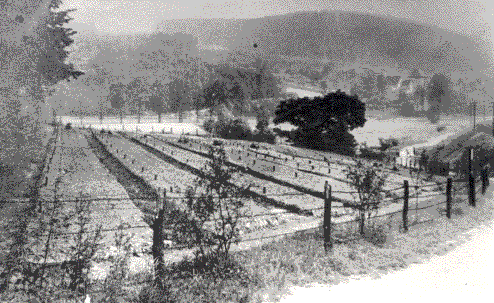 |
Russian cemetary Höcklingser Weg, undated (1943) (Bundesarchiv - Militärarchiv Potsdam)
These men since their captivity and the following stay in
front STALAGs and torturing long , ice-cold transportation from the war
front to Hemer had suffered hell and were instantly put to work. Even the
strongest ones were at the end of their power. Casualties rose immensely
and neither the STALAG command nor local authorities had been prepared. In a
hurry the city of Hemer rented a piece of land from the protestant church
adjacent to the churchyard as a burial place for Soviet Prisoners of
War.
Wrapped into paper the corpses have been transported on a horse
cart the shortest way from STALAG to Höcklingser Weg- a burial command had
to throw the corpses into the mass graves without any form of ceremony.
Bypassers on the Höcklingser Weg and even passengers from the passing
trains, the railroad track from Hemer to Menden is right next to this
burial place, could witness these cruel occurances. The horse cart soon has
been known to the people living en route by its regularity. The intention
of the Wehrmacht to act well covered and without publicity simply
could not be followed.
In the beginning of 1943 this graveyards
capacity did not allow for more- it literally was overcrowded so it had to
be closed. In only 15 months about 3000 corpses had been put into 16
mass graves.
Beginning of 1949 the premises have been reconstructed so
it became a lawn with birch trees. The placement of the graves and
original paths dissappeared. Even small metal signs have been done away
with so visitors of today will not recognize the whereabouts of the rows
of the graves. In the end of 1965 an old small concrete monument, put
there by Russian prisoners shortly after the liberation decayed after 20
years has been replaced by a monument of a local artist, Walter Voss of
Menden. 26th of November 1967 the national remembrance day of the dead, this
monument has been dedicated in a ceremony. One more restauration took
place in 1975 which lead to the form this war cemetery has today.
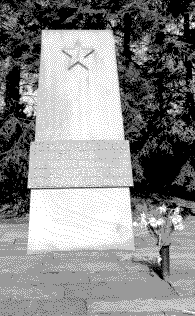 |
monument in the so called Russian Cemetery, Höcklingser Weg 1993 (Stadtarchiv, Hemer, Fotosammlung)
A fence and a hedge surround the cemetery with its
2972 square meters. The entrance is from Höcklingser Weg by a gate and
stairs to the monument which consists of three tapering square stones. The
middle one carries the letters "Here rest 3000 Soviet citizens who died in
the years 1941 until 1945 far from home". On top of the middle square
stone a chiseled Soviet Star is put.
Duloh Cemetery
End of March 1943 Stalag received a piece of land some 2 km away on top of Duloh hill west of the city center. This place was located further away from the camp than the first burial place and because of the relative steep way up not so easy to reach but it was well away from settlement. This place actually belonged to a large military site just between a shooting-practice range and a depot for ammunition further westward of the Duloh. This military site had been securely fenced and guarded by soldiers from Iserlohn Seydlitz barracks. Most civilians of Hemer kept away from this site because of the military character and because of the shooting range. So all what happened at this place could not be seen by any civilian. The route of the cart with the dead corpses led across the town center passing through Ostenschlahstreet, crossing the railtracks, passing the Friedrich List Street, An der Steinert, up via Dulohstreet and finally by a gravel road passing by the shooting range and then arriving at the burial place. Without any dignity the corpses had been laid to the ground as it used to be at the cemetary Höcklingser Weg. In the Stalag they used to undress the corpses, wrap them into oily paper and pack them. When in the last year of the war there was no paper left, corpses had been thrown naked on to the cart. People living in the upper stories of the houses en route have had this horrible view of the packed naked corpses. This remembrance still haunts some former residents of these houses. A witness writes: "At this time settlement near the camp had not been so dense, we could easily watch the entrance of the camp. One evening, it was summertime and we sat in the garden, it happenened that a wheel of the cart broke, the wrapped corpses were put on the road to wait for a new cart. One other day in dusk they simply lost a corpse. A neighbour found him and reported this to the post at the entrance. Whenever the cart reached the burial place the burial group started their work.One of the guards, having witnessed all this, reported:
Some of the prisoners, bribed with alcohol or extra food had the sad task to bury the daily rate of casualties, to collect them and transport them on a cart to the burial place behind the shooting range and lay them to earth into mass graves. On duty at the shooting range I could see one morning towards five o`clock the cart approaching and heard the officer on duty say : Here again comes a load of "Iwan kaputt". I followed the cart and saw that it drove to a hole in the ground, about 3m deep, and 3m wide, right adjacent to existing burial places, half full already. When the cart had reached the border of the hole the driver, in his dirty, rotten uniform, removed the back side of the cart and instantly there was this horrible view of of naked or paper wrapped corpses, packed on top of each other. Now the driver took a spade and removed some earth from the inner side of the hole- again an unforgettable sight of partly decaying corpses. With an iron hook he now drew one after the other corpse or a bundle of corpswes from the cart into the grave, letting the corpses toss down. Then with his hands- he wore long gloves- he packed the corpses about 1.5 m high, pressing them into position with spade or boots. Then again the top and front of this pack was covered with earth and then this awsome, horrible, inhuman way of burial ended- the cart moving back to the Stalag ready to repeat this procedure who knows how many times. I had counted 25-28 dead, who after all the tortures they must have suffered from the Germans and after this inhuman procedure of burial finally were resolved and found their last place to rest. Afterwards I learned from the officer that what I had witnessed happened a couple of times a day and in summer weather also at night. A group of Soviet prisoners had the command to dig such holes 3m wide and 2.50 deep all the time, so that four layers of corpses, skeleton like skinny corpses, would fit there. For these procedures there had been exact orders by the Wehrmacht.
After the liberation of the camp on April 14th, 1945 the mortality rate stayed almost as high as the weeks before with about 100 dead each day because the improvement of the situation of food and medical treatment by the American Army showed effects only slowly. For many of the prisoners help came too late because of the long period of starvation and recovery was not possible. By end of April mortality rate sank to a third and then rapidly during the following months.Beginning April 28th a list of casualties after the liberation showed the death of 790 persons after liberation. From 28th to 30th of April 96 persons, in May 252, June 111, July 83 and August 43 persons had been buried at the Duloh cemetary.
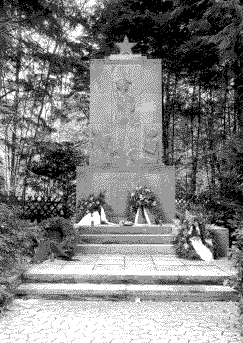 |
Sovjet Memorial at the Duloh - Cemetary at the war remembrance day 1999 (Stadtarchiv Hemer, Fotosammlung)
After the war the Soviet mitlitary authorities
ordered a memorial monument. The Russian architect Lewitzkij designed it
and on October 9th 1945 the monument was dedicated in a ceremony in
presence of Soviet and British officers and the mayor of Hemer Kleffner.
The monument is still there, it has a hight of 6m and is carved from a
green-gray dolomite stone from Anröchte. It has a base with steps, a
postament with engravings and in the main part a relief in the front. This
relief shows in typical Soviet realism three by their slavery suffering
prisoners of war. A soviet star with hammer and sickel crowns the monument.
On three sides the postament carries engravings in Russion. Translated it
says: (front side, right side, left side) :
To you who suffered torture
and pain far away from home, deceased in fascist slavery eternal
remembrance and eternal rest, 1941-1945
The ones who tortured you to
death could not get away without punishment which came to them. With
mighty force they have been swept away bound for their graves themselves.
Rest quietly.
From home a big light streams on you like a large river.
Red Army sentinels protect your peace.
According to official
statements of February 1946 on Duloh cemetary 19.979 deceased have been
buried in mass graves and 22 single graves. This number increased by
transfer of graves from other places like Haseloh from where the remains
of 253 Soviet soldiers were brought to the Duloh in the time from April to
the end of the year 1945.
The slightly higher graves with metal plates
in rows had been levelled to better mow the lawn throughout, the metal
tables disappeared in 1949. In 1963 uniform graveplates had been placed
into the ground. and in 1966 the monument was restaurated thoroughly after
the original plan of the city of Hemer to erect a new one was dropped
because of finances. In the beginning of the year 1987 the city of Hemer
placed a plate with the translation of the engravings of the monument. Another plate with information for visitors at the gate has the following
text: "More than 20.000 victims of the national-socialist dictatorship and
of war, victims of different nationalities yet most from the Soviet Union
rest here. The Soviet prisoners of war falling ill from forced labour, and
starving almost to death were brought back to the STALAG- the central camp
No. VIA, There they died from starvation and illness."
Several times
the plates have been attacked or destroyed so that the police kept watch
for a while and even managed to save it in one case. From 1982 on a yearly
remembrance celebration is held there. In 1996 as a sign of belief and
hope a large Russion orthodox cross has been placed at the right side of
the central pathway , on November 17th. in presence of many inhabitants of
Hemer and representatives of the Russian-Orthodox Church it was
consecrated. The cemetary on Duloh is open to the public and several signs
lead from the city of Hemer to this war cemetary. It has 6728 square
meters and there is a fence and a hedge around it. Birch trees give the
place the impression of a peaceful park. The mass graves cannot be seen
under the lawn, only some plates and the 22 single graves in two rows on
the left side, 74 single graves next to the fence and hedges are in the
northeast corner of the place. Here the stele monument carved by a
Frenchman in 1941 found a place. In these single graves only a small
number of Soviet soldiers are buried, Yugoslaw, Polish, Rumanians and
Belgians together with ten female labourers from abroad with three
children found there rest. A large number of these has been transported
here from other burial places (Waldfriedhof and Italien
cemetary).
According to until now not officially testable
information in this burial place 20.470 corpses, mostly Soviet prisoners
of war have been buried. The list of 1975 shows only 717 dead, only 702
with their names. In these cases they are casualties after the liberation
of the camp or some changes from other burial places where the names had
been known before. The Stalag casualties had been registered by the camp
itself - but all the documents of the camp itself have disappeared or
brought away. Exept 23 casualties from the years 1942 until 1944 have been
registered with town authorities. So from there information cannot be
obtained. But newer research has shown that in many cases one can receive
information- names and the whereabout of the graves- in archives in Berlin
and in Podolsk near Moscow.
The Mass-Grave at Haseloh
After 14th of April 1945 American soldiers witnessed a cruel sight: In the mortuary cellar of block 5 dead corpses were piled up to the ceicling. Artillery shooting a couple of days before caused many casualties and the near end of the war lead to dissolvement of the administration so in this chaos the transport of the dead corpses stopped. The increasing decay of the dead corpses meant actual danger of diseases for the remaining people in the camp. American authoristies ordered the immediate transport of the corpses to a place nearby where again massgraves had been prepared. Because the fence near Haseloh street was open and it was near to block5 it was possible to transport the dead by trucks to the Haseloh burial place- this was done by German prisoners of war.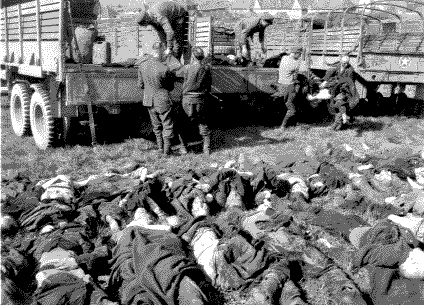 |
Transport (16.4.1945) of 253 Russian corpses found in block 5 to the mass-grave "am Haseloh" (National Archives, College Park, USA)
This mass grave was situated
on premises partly where today apartment buildigs are, in the triaqngle
Aldegreverstr./ Dürerstr./ Holbeinstr.. The burial place , about 50x6 m
existed until Dec. 1946. Under command of the American Army these 253
corpses had been transferred to the Duloh.
The Italian burial place on Duloh
Some 50 m. southwest of the Russian burial place until 1957 there had been a special burial place for Italian military prisoners. In spring 1945 the first 122 deceased Italians of STALAG had been buried by fellow-Italians from military hospital of Stalag . Early in 1946 75 who had been buried at the Waldfriedhof were transferred there, too. After some more transfers this burial place reached its largest number of dead in 1949. In July 1957 a German-Italian agreement lead to the transfer of all 182 Italians to a central cemetary in Frankfurt/Main. After clearance from other nationalities and tranfer to the Duloh this site was given up and since then belonged to the British Army campsite.The Dead of STALAG VIA
Just like in the other places where STALAGs had been installed (z.B. Schloß Holte-Stukenbrock, Fallingbostel, Bad Orb, Hammelburg u.a.) often questions for the exact historical number of dead, their names and numbers, are posed. The same situation in all places: Unbelievably high numbers roughly rounded from different sources had to be questioned because of missing documents of official status. According to such sources one has to count up to 24.000 dead of different nationalities. During the last years in all the places where Stalags had been, there was dispute about the dimensions of the unbelievable extent. Some think the numbers are too high, others come to even higher numbers by the method of inference. Both tendencies are not helpful for the objective to simply deal with that part of German history. To quarrel about numbers is not very helpful. The work we started is a work of remembrance of that time in all its aspects. To deal with Stalag history does not depend on exact numbers rather it is necessary to mediate what happend during this period of time to the future generations. Publications of this sort are to clarify which dimensions of evil may happen in the name of some sort of ideology, where the roots of this behaviour are, and why man might break with all traditions and moral boundaries. Prerequisite for such sustaining honest tradition of history is the objective documentation with facts, not open for interpretation from one side or the other.According to research of historians after 1997 there is a chance to come to facts about numbers and names of dead in a precision unbelievable until now. Newly found documentation from the former German military services office still named "Deutsche Dienststelle für die Benachrichtigung der nächsten Angehörigen von Gefallenen der Deutschen Wehrmacht" in Berlin and the "Central archives of the Russian Ministry of Defense" in Podolsk near Moscow and the data found there prove that also the Soviet prisoners of war had been documented on data sheet - which until now was not known and not believed by historians. Meanwhile the town archive has proof already about 1000 dead from these documents and can spot their graves. In the years to come more documents will be processed so that there is hope to be able to retrieve most dead from their anonymity and to proof that not only 3000 dead from Höcklingser Weg is a realistic figure but also that the horribly high number of dead on Duloh has to be corrected down. Final results of this hstoric research is to be awaited.
When discussing the situation in Hemer it must be remembered that there is a large number of thousands of prisoners of war who died on their way walking to work in different cities of the Ruhrgebiet, sent into external camps, died by cruelties of German soldiers under way, or of air raids and had been buried near the places where they deceased.